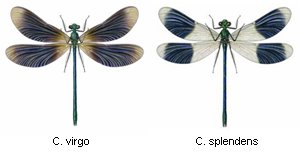 |
| Calopteryx
virgo |
 |
|
Common Name:
|
Beautiful Demoiselle |
|
Odonata |
|
Order:
|
Odonata |
|
Suborder:
|
Zygoptera |
|
Family:
|
Calopterygidae |
|
Genus:
|
Calopteryx |
|
Species:
|
C. virgo |
|
|
| The
Name |
| Calopteryx virgo (Linnaeus, 1758),
the Beautiful Demoiselle, is a European damselfly. It is often found among
fast-flowing waters.
Length around 45-49mm, wingspan for
male around 58mm and for female around 63mm; Hindwing around 24-36mm; Larva
around 30-35mm.
The male has dark brown-black wingtips
with blue veins. Immature insects often have much paler, browner wings.
They have metallic blue-green bodies and blue-green eyes. The female has
dark brown iridescent wings, a white patch near the tip of the wings and
a metallic green body with a bronze tip of the abdomen.

Comparing with similiar family species
Calopteryx splendens (Banded Demoiselle), the difference exists in extention
of the band in the wing patch. The wing patch of C. splendens starts
at the nodus but can reach up to the wing-tip in southern races. The nodus
is the sharp dip mid-way down the upper edge of the wing. That of the C.
virgo, the colouring on the wing starts before the nodus, further towards
the body, than the Banded demoiselle.
Demoiselles are damselflies that
belong to the family group called "Calopterygidae". This family includes
two large damselfly species: the Banded Demoiselle Calopteryx splendens
and the Beautiful Demoiselle Calopteryx virgo. Demoiselles have a graceful
butterfly-like fluttering flight and are usually seen flying over riverside
vegetation.
|
| The
Characteristics |
| Territorial males perch on bankside
vegetation. They will flick their wings open and shut, occasionally chasing
off passing insects, often returning to same perch. Females only visit
water for egg-laying or seeking a mate, both sexes frequently stray well
away from water. Flies slowly with a butterfly like flight and frequently
settles on bankside vegetation or trees.
Preferred environment includes upland
and lowland unpolluted lotic sites especially with wooded banks and of
moderate flow with sandy and gravely beds. Restricted to faster running
clear water, found only along streams and rivers, often acidic, with sand
or gravel bottom. Mostly found along heathland or moorland streams, though
can also occur in farmland and woodland, including well shaded streams.
Prefers cooler water than Banded Demoiselle. As streams broaden this species
gives way to Banded Demoiselle, where there may be a broad overlap. Occasional
hybridisation may take place. Sensitive to waterway management (clearance
of vegetation) and pollution.
|
| The
Reproduction and Development |
Females oviposit alone with male
guarding, laying up to 300 eggs at a time on emergent or floating plants,
often on water-crowfoot. Like the Banded Demoiselle, they often submerge
to do so. The eggs hatch after around 14 days. Again, like the Banded Demoiselle,
the larva is stick-like with long legs and develops over a period of two
years in submerged vegetation, plant debris or roots. They usually overwinter
in mud or slime. Emerges at night on low vegetation often some distance
away from habitat. Main flight period is late May to end August.
|
| The
Distribution |
This species occurs Europe, western
Asia and northwest Africa.
|
| The
Protection Status |
| Common, not theathened. |
|
References:
http://en.wikipedia.org/wiki/Beautiful_Demoiselle
http://www.habitas.org.uk/dragonflyireland/5616d.htm
|
| The
Species on Stamps |
|
|
|
|
With courteous to Mr. Richard
Lewington for the Dragonfly Illustration
|
|
|
|
Home | Country
List | Species List
|
|